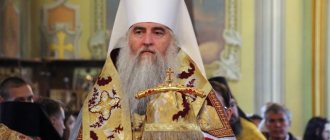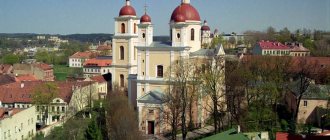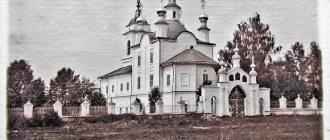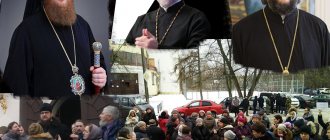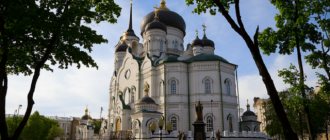| Metropolitan Ignatius (Deputies) |
Ignatius (Deputatov)
(born 1977), Metropolitan of Saratov and Volsky, head of the Saratov Metropolis In the world of Deputatov Alexey Mikhailovich, was born on January 22, 1977 in the village of Tugoles, Shatura district, Moscow region, in the family of a priest.
From 1984 to 1994 he studied at secondary school No. 5 in the city of Shatura. In 1993 he graduated from the Shatura Children's Music School in the Accordion class.
From 1994 to 1996 he studied at the Ryazan Orthodox Theological School. In 1996, he entered the third year of the Samara Theological Seminary, after which in 1998 he was sent to the disposal of the Ryazan bishop and recommended for admission to the St. Petersburg Theological Academy, which he entered in the same year.
On November 22, 1998, he was installed as a reader by the rector of the St. Petersburg Theological Academy and Seminary by Bishop Konstantin of Tikhvin in the Church of the Holy Apostle John the Theologian of the St. Petersburg Theological Academy.
In June 2002, he defended his thesis on the topic: “Fundamentals of the Social Concept of the Russian Orthodox Church in the light of the Holy Scriptures of the New Testament.”
Upon completion of his studies at the Academy, he was sent to the disposal of the administrator of the Ryazan diocese, for teaching at the Ryazan Orthodox Theological School. Since August 2002, he was accepted as a teacher of the subject of Biblical history at the Ryazan Orthodox Theological School.
On October 27, 2002, he was tonsured into a mantle with the name Ignatius, in honor of the Hieromartyr Ignatius (Sadkovsky), Bishop of Skopinsky.
On October 31, 2002, he was ordained to the rank of hierodeacon by Metropolitan Simon.
On November 4 of the same year, he was ordained to the rank of hieromonk in the St. Nicholas Church in the city of Skopin, Ryazan region.
On July 23, 2003, he was appointed vice-rector for educational work of the Ryazan Orthodox Theological School.
In September 2003, he was appointed teacher of the subjects: “Pastoral Theology”, “Homiletics” and “Fundamentals of the Social Concept of the Russian Orthodox Church”.
From 2004 to 2007, he was a postgraduate student at the Moscow Theological Academy at the Department of External Church Relations of the Russian Orthodox Church.
On March 15, 2005, he was appointed dean of the seminary’s churches, retaining the post of vice-rector for educational work of the Ryazan Orthodox Theological Seminary.
On October 6, 2005, he was appointed abbot of the newly opened Spaso-Preobrazhensky Monastery in the city of Ryazan.
| Hegumen Ignatius (Deputies) |
In 2007 he was elevated to the rank of abbot.
In 2008 he graduated from Ryazan State University. S.A. Yesenin with a qualification as a lawyer with a degree in Jurisprudence.
On May 27, 2009, he was relieved of the post of vice-rector for educational work and appointed first vice-rector of the Ryazan Orthodox Theological Seminary to coordinate the work of the educational and administrative departments of the seminary.
On June 23, 2009, he completed his master’s degree at the Uzhgorod Ukrainian Theological Academy named after Saints Cyril and Methodius, and on December 24 he defended his doctoral thesis on the topic “Veneration of icons in the light of the definitions of the Ecumenical Councils of the Orthodox Church” with the award of the academic degree of Doctor of Theology.
In 2010, he underwent professional retraining at the Moscow Academy of State and Municipal Administration, upon completion of which he was awarded a qualification to conduct professional activities in the field of state and municipal administration, management of organizations, enterprises of various forms of ownership and personnel management. Since August 2010, he has been a candidate for the degree of Candidate of Economic Sciences at the Moscow Academy of State and Municipal Administration.
In 2011, he was appointed first deputy director of the Ryazan branch of the autonomous non-profit organization of higher professional education “Smolny Institute of the Russian Academy of Education”.
On July 27, 2011, by decision of the Holy Synod, he was elected Bishop of Shakhtinsky and Millerovsky.
On August 18, 2011, he was elevated to the rank of archimandrite by Patriarch Kirill of Moscow and All Rus' in the lower Church of the Transfiguration of the Cathedral of Christ the Savior in Moscow, and on the same day in the Throne Hall of the Patriarchal Apartments of the Cathedral of Christ the Savior he was named.
| Bishop Ignatius (Deputies) |
On August 21, 2011, he was consecrated Bishop of Shakhtinsky and Millerovsky.
The ordination in the Transfiguration Cathedral of the Novospassky Monastery in Moscow was led by Patriarch Kirill (Gundyaev) of Moscow and All Rus'. Concelebrating with him were: Metropolitans of Krutitsky and Kolomna Yuvenaly (Poyarkov), Saransk and Mordovian Varsanuphiy (Sudakov); Archbishops of Istra Arseny (Epifanov), Ryazan and Kasimov Pavel (Ponomarev), Kostroma and Galich Alexy (Frolov); bishops of Rostov and Novocherkassk Mercury (Ivanov), Bronnitsky Ignatius (Punin), Solnechnogorsk Sergius (Chashin), Podolsk Tikhon (Zaitsev), Voskresensky Savva (Mikheev). On December 27, 2011, he was released from the post of abbot (abbot) of the Spaso-Preobrazhensky Monastery in the city of Ryazan [1].
On December 26, 2012, he was confirmed as the Holy Archimandrite of the Verkhnemakeevsky Pokrovsky Monastery [2].
On May 30, 2014 he was transferred to the Vologda department [3].
On July 25 of the same year, he was confirmed as the Holy Archimandrite of the Spaso-Prilutsky Dimitriev Monastery in the city of Vologda and the Kirillo-Belozersky Monastery in the city of Kirillov [4].
On October 23, 2014, he was appointed head of the newly formed Vologda Metropolitanate with the title “Vologda and Kirillovsky” [5]. From October 23 to November 23, 2014, he also temporarily ruled the Cherepovets and until May 2, 2021, the Veliky Ustyug dioceses, until the consecration of new bishops.
On November 4, 2014, he was elevated to the rank of metropolitan by Patriarch Kirill of Moscow and All Rus' in the Assumption Cathedral of the Moscow Kremlin [6].
On December 25 of the same year he was appointed rector of the revived Vologda Theological Seminary [7].
On February 26, 2021, he was appointed chairman of the Financial and Economic Administration of the Moscow Patriarchate [8] and rector of the Church of the Life-Giving Trinity in Khoroshev, Moscow. Member of the Supreme Church Council ex officio.
On December 26, 2021, he was relieved of his post as rector of the Vologda Theological Seminary. Member of the commission for organizing the life of monasteries and monasticism in the Inter-Council Presence of the Russian Orthodox Church.
On March 11, 2021, he was again appointed temporary administrator of the Veliky Ustyug diocese [9].
On August 25, 2021, he was appointed Metropolitan of Saratov and Volsky, head of the Saratov Metropolis, with release from the administration of the Vologda diocese and from the post of chairman of the Financial and Economic Administration of the Moscow Patriarchate.
Awards
Church
- Gaiter (2003)
- pectoral cross (2004)
- bishop's letter (2008)
- anniversary memorial sign of the St. John the Theologian Monastery, 1st degree (2009)
- bishop's letter (2009)
- anniversary bishop's letter (2009)
- club (April 5, 2010)
- pectoral cross with decorations (at elevation to the rank of archimandrite, August 18, 2011)
Secular
- diploma from the Federation of Peace and Reconciliation (2006)
- Certificate of the Russian Peace Foundation (2006)
- Certificate of the Russian Peace Foundation (2007)
- anniversary medal of the 70th anniversary of the Ryazan region (2007)
Nezygar published a 10-minute recording of a telephone conversation.
(I received this recording on the 9th, but I don’t understand how to upload the audio file to LJ format).
Metropolitan Ignatius (Deputies) of Vologda and Kirillov fell victim to a telephone prank.
He received a call from the famous pranker Evgeniy Volnov, who introduced himself as an employee of the “Department for Combating Sects and Destructive Cults” (What?)
The Metropolitan, whom the interlocutor calls in secular terms Alexei Mikhailovich, answers questions about the personality and fate of the Cherepovets Bishop Flavian (Mitrofanov).
There's a lot of interesting stuff in the conversation.
For example, completely commercial terminology instead of “pre-agreed donations.” The very position of “a rabbit in front of a boa constrictor”, which is occupied by the Metropolitan and the head of the financial department of the Patriarchate in front of an anonymous intelligence officer.
And yet - that second when, starting to suspect something wrong, he tries to get out of the conversation, but the prankster puts up a trump card: they say Bishop Mitrofanov testifies against you that you are from the same homosexual party.
And the Metropolitan is not indignant, does not deny, does not shout that this is such a waste, does not hang up, but wilts and continues the conversation, laying out everything he knows.
It is difficult to regard this as anything other than coming out. 1 min 42 sec:
— during interrogations, Bishop Flavian does not hide his unconventional orientation, neither his nor yours. - yes. - Of course, we can call you and get your answers here, understand? - okay, what?
Later, at 6 minutes 40 seconds
— as I already said, Flavian does not hide either his or your gay orientation. - wait, how can he even talk about me? He doesn't know me at all. - Apparently he knows, since he speaks. Maybe you had some interactions with him? - Yes, in general, complete stupidity.
- that is, even if he says this, it has nothing to do with reality? - well, I didn’t know him, I didn’t really know him.
- Well, maybe they knew someone whom he knew? Maybe you had an interaction with someone that was unconventional? (pause) - unconventional?.. Yes, to be honest, when I proposed him, it didn’t occur to me, because he has a son, a wife...
*** They tell me that it was out of excitement that he didn’t get everything.
“The excitement is simply due to such a call, believing that a representative from the competent authorities is speaking to him.” Are we in '37? These bodies have long been at the beck and call of the patriarchy. Why be afraid of a call from colleagues, especially with little stars? And this is the bearer of the financial secrets of the patriarchy!
if “everything didn’t dawn on him right away,” then maybe it’s not worth keeping such a brake on such positions?
They don't hire people like that for intelligence purposes. And the prankster worked professionally! I wonder for whom he made room for the head of KHOZU.
IGNATIUS
St. Ignatius Prilutsky. Painting of the Archangel Cathedral of the Moscow Kremlin. 1652-1666
St. Ignatius Prilutsky. Painting of the Archangel Cathedral of the Moscow Kremlin. 1652-1666 On the miniatures of the Shumilov volume of the Front Chronicle of the 70s. XVI century capture of the prince being taken into custody. Andrei Vasilyevich of Uglich and his sons John and Dimitri, where I. is depicted in princely clothes and a hat, beardless, without a halo (RNB. F. IV. 232. L. 457 vol. - 459 vol.). Information about images of I. con. has been preserved. XVI - 1st quarter. XVII century in the basement of the cathedral in honor of the Origin of the honorable trees of the Cross of the Lord (the All-Merciful Savior) of the Dimitriev Prilutsky Monastery: the image of I. (as the image of the blessed prince Dimitri Andreevich of Uglich) was located next to the icon of the Mother of God; near I.’s tomb stood an icon of the Savior (like the Savior of Smolensk) “with the venerable fathers Demetrius of Prilutsk and Ignatius of Ugletsky” (GIM OPI. F. 61. D. 113. L. 37; GAVO. F. 512. Op. 1. D. 21).
The All-Merciful Savior, with the fallen Saints Demetrius and Ignatius of Prilutsky. Banner. 40s XVII century (VGIAHMZ)
The All-Merciful Savior, with the fallen Saints Demetrius and Ignatius of Prilutsky. Banner. 40s XVII century (VGIAHMZ) One of the earliest surviving images of I. is in the murals of the Archangel Cathedral of the Moscow Kremlin (1652-1666, according to the iconographic program 1564-1565) to the north. north-east border pillar in the 3rd tier. I. with a halo, in a blue peaked schema with red crosses, in a dark brown mantle and an ocher cassock, without a belt; both hands are near the chest, the left one is open with the palm facing outward. He is depicted as a medieval man with a short, pointed beard. The image of the saint is addressed to the burial place of his father - Prince. Andrei Vasilyevich Uglichsky, which may indicate the state’s prayer-repentance. authorities in the person of the tsar for misconduct before the princes and relatives (Samoilova. 2004. P. 206).
On icons and in monumental painting, I. was mainly depicted in a schema, with a doll on his head. In the iconographic originals of the last. Thursday XVII - 1st half. XIX century under May 19 and June 23, the following description of the saint’s appearance is given: “in the schema, [like] Alexander Oshevensky” (IRLI (PD). Bobk. No. 4. L. 112); “like Varlam in the schema, supersed” (Ibid. F. Department of receipts. Op. 23. No. 294. L. 160); “in the schema, like Ephraim the Syrian, superintendent” (Ibid. Peretz. No. 524. L. 162; in other RKP. added: “the monk’s robe, with green underside” - RNB. Weather. No. 1931. L. 157); “in the schema that Ephraim the Syrian, and in another they write nadsed, brother of Vasily the Great” (BAN. Strict. No. 66. L. 108; see also: Bolshakov. Iconographic original. P. 99-100). Judging by some descriptions, there was also princely iconography of I.: “Little oversat, like Varlaam Khutyn[sky], he is wearing a fur coat” (IRLI (PD). Bobk. No. 4. L. 123); “over, the brad of Basil of Caesarea, the prince’s robe” (Ibid. Peretz. No. 524. L. 175 vol.). A manual for icon painters in 1910 says: “... not old, like a Russian, with a thin face, a narrow beard, but rather long, with a little gray; monastic clothes, on the head of a schema. In his hands is a charter with his saying: “Do not grieve, brother, from prison and from these bonds, God has informed our order and the sovereign about us of taxes useful to our souls: first teach us about this light, do not worry about vanity, but let us pray to the Lord. God, that the Lord God may send His mercy to us, that we may endure with joy in His name and be delivered from eternal torment” (Fartusov. Guide to the Writing of Icons. P. 287).
Reverends Demetrius and Ignatius of Prilutsk, with the life of St. Dimitri. Icon. 2nd half XVIII century (VGIAHMZ)
Reverends Demetrius and Ignatius of Prilutsk, with the life of St. Dimitri. Icon. 2nd half XVIII century (VGIAHMZ) By the 50s. XVII century there is a mention of the 1st gravestone icon of I. (not preserved, see: GAVO. F. 512. Op. 1. D. 44. L. 77 vol.). Embroidered tombstone from the 60s. XVII century (VGIAHMZ, first mentioned in the inventory of 1675 among newly arrived church things - VGIAHMZ OPI. F. 3. Inventory 1. D. 1. L. 105 volume; dated by A.V. Silkin, 2nd half. 50 - 17th century - Silkin A.V. Workshops of face sewing in the house of boyar I. D. Miloslavsky (in print)), created in the Moscow workshops of boyar I. D. Miloslavsky, conveys a version of ancient iconography: the saint is depicted in a doll , blessing, with a scroll in his left hand. In the image of I. there are individual features: a wide face, close-set eyes, a straight nose, a light brown beard narrowed downwards with light gray streaks, a short, broad-shouldered figure, large hands. At the top there is a half-length image of the Savior Almighty, on the borders there is a general troparion and the beginning of the kontakion for the saint. Close to the image on the cover, the image of I. is on the analogue icon of selected saints of the 17th century. (VGIAHMZ) from the Dyudikova Ioanno-Predtechenskaya monastery, located not far from the Spaso-Prilutsky Monastery. According to the inventories of 1819 and 1914, on I.’s tomb there was his image “in full size, in the schema” (Ibid. D. 16. L. 15 vol.). On the icon XIX century (sacristy of the Spaso-Prilutsky Monastery), made in the tradition of a tombstone image, I. is written (originally in full length, in a blue schema with yellow crosses, the right hand near the chest, in the left, lowered, a scroll) together with St. Dimitry Prilutsky. In the iconostasis the so-called tents on the lower floor of the Cathedral of the All-Merciful Savior, where, according to legend, the cell of St. Demetrius, in 1914, to the right of the royal gates, an icon of I. with the blzh. Nikolai and MC. Daria in the fields (Ibid. D. 22. L. 16). In the porch of the lower church in 1914 there were icons of the Prilutsk wonderworkers: the image of I. - on the right, St. Demetrius - on the left (Ibid. D. 1. L. 21 vol.).
St. Ignatius of Prilutsky is among the selected saints. Icon. 1715 Icon painter L. Tufanov (VGIAHMZ)
St. Ignatius of Prilutsky is among the selected saints. Icon. 1715 Icon painter L. Tufanov (VGIAHMZ) Since the 17th century. Images of I. were distributed along with St. Demetrius of Prilutsky in prayer to the Lord Almighty. I. with the inscription: “Vologda miracle worker” - was depicted in the lost mural of St. gates of the Spaso-Prilutsky Monastery, made in 1635 by the Kostroma icon painter Denis and his comrade Terenty. His image was presented in a Deesis-type composition on the outside of the gate; “at the foot of those praying to the Almighty Savior” it was painted on the inside of the gate. The craftsmen also made a “local” image of the Prilutsk miracle workers “on one floor. Above is the Fatherland" (GAVO. F. 512. Op. 1. D. 49. L. 45, 48-49; see: Kochetkov. Dictionary of icon painters. P. 177). Later, Deesis icons with images of both saints were placed above the entrance to monastic cells. In the inscriptions the saint is usually called “Reverend Prince Ignatius.”
The earliest surviving images of I. from this version are the banners embroidered for the Spaso-Prilutsky Monastery of the 40s. XVII century and shroud 1st half. XVII century (VGIAHMZ), in which I. is presented in prayer (kneeling and standing tall, respectively), in a rounded schema, with an elongated dark beard. The iconography of the shroud (the figure of I. on the right side of the composition, half-turned to the left, sometimes with a scroll in his hand, in a doll, unlike St. Demetrius) is repeated on the icons of the middle - 2nd floor. XVII century from the churches of Vologda and those places where there were monastic estates and farmsteads (VGIAHMZ, AMII - from the sacristy of the Solovetsky Monastery, State Historical Museum, private collection of N. S. Panitkov). The life-size image of I. in the schema is engraved on the 17th-century pellet decorating the mantle of the phelonion (VGIAHMZ), in the bottom row, to the right of the central image of St. Basil the Great, with the inscription: “Rev. miracle worker Prince Ignatius"; his paired image is St. Demetrius Prilutsky, together with Rev. Alexy, man of God, with St. Nicholas the Wonderworker, with the Great Martyr. Theodore Stratilates. The iconography of the banner (I. falls to the All-Merciful Savior together with St. Demetrius of Prilutsky) is repeated by the 18th century icon. from Iliinskaya church Vologda (VGIAHMZ), on which the saints are depicted kneeling.
The All-Merciful Savior with Saints Demetrius and Ignatius of Prilutsky in prayer. Fresco of the pediment of the porch of the Spassky Cathedral of the Savior-Prilutsky Monastery. 1998 - approx. 2000 Master A.V. Aleshin
The All-Merciful Savior with Saints Demetrius and Ignatius of Prilutsky in prayer. Fresco of the pediment of the porch of the Spassky Cathedral of the Savior-Prilutsky Monastery. 1998 - approx. 2000 Master A. V. Aleshin On the basis of this iconography, a composition of icons of the Lord Pantocrator with the Vologda miracle workers was formed, which became widespread in Vologda in the 18th-19th centuries. Apparently, one of the first icons was in the main iconostasis of the Cathedral of the Spaso-Prilutsky Monastery (2nd half of the 17th century, VGIAHMZ) - the saint in the schema stands before the Savior among 28 local saints (inscription: “Reverend Prince Ignatius”). On an 18th century icon. from c. Nativity of the Most Holy Mother of God on the Upper Valley (VGIAHMZ) I. in the right group at the top, next to St. Alexy, Metropolitan Moscow; on an 18th century icon (GRM) - far right at the bottom of the group; on the icon XVIII - beginning XIX century (central right of Lazarus in Vologda), made in a picturesque manner, the kneeling saint on the left in the 1st row, with a long rosary on his hand. On the icon of 1779, painted by Vologda masters Dimitry and Ivan Sumarokov for c. St. Nicholas the Wonderworker in the Vladychnaya Settlement of Vologda (VGIAHMZ), I., with a light brown beard without graying, forked at the end, in a blue schema, red mantle, ocher cassock, depicted falling to the Savior, opposite St. Dimitri. Variants of the composition are also known in works of the 18th-19th centuries. from Trinity (Gerasimovskaya) church. on Kaisarov Stream, from the c. Transfiguration of the Savior on the Swamp, from the seminary church. St. Kirill Belozersky in Vologda (VGIAHMZ).
In the XVII-XX centuries. images I. and etc. Demetrius as St. patrons of the Spaso-Prilutsky Monastery were complemented by the view of the monastery. The earliest example is on the icon of Ser. XVII century (after 1654, GMZK): the monks hold a model of the monastery (view from the north side) (see: Polyakova. 2006. P. 202). In a similar way, I. is depicted in the middle of the hagiographic icon of St. Dmitry Prilutsky 2nd floor. XVIII century from c. Vmch. St. George the Victorious on Navolok in Vologda (VGIAHMZ). The icon shows the 1st floor. XVIII century from the Gorny Assumption Monastery of Vologda (VGIAHMZ) Prilutsk wonderworkers are depicted half-turned to each other with scrolls turned upward (text from I.: “Lord Master, Holy King, have mercy on those who call on Your holy name...”), between the figures there is a panorama of the monastery. A similar image in an iconographic manner is on an icon of the 19th century. from the Cathedral of the Nativity of the Virgin Mary in Vologda (I. in the schema extends his hand to the Savior, depicted above the church buildings). On some icons of the 19th century. St. Demetrius and I. (with their hands folded crosswise or prayerfully on their chests) are shown frontally against the backdrop of the monastery (VGIAHMZ). On the picturesque enamel image, gray - 2nd floor. XIX century (VGIAHMZ) both saints are without kukol, gray-haired, with unfolded scrolls. A unique pictorial icon of the 19th century. written in the Vologda prison by convict M.V. Solovyov (private collection, Vologda).
St. Ignatius Prilutsky. Icon 2001 (Spaso-Prilutsky Monastery)
St. Ignatius Prilutsky. Icon 2001 (Spaso-Prilutsky Monastery) On icons of the 17th-18th centuries. I. was often depicted among selected saints and in the fields. All R. XVII century Pyadnitsy icons with the image of I. were in the main iconostasis and to the southeast. pillar of the monastery cathedral. The saint was written on the icon of St. Dmitry Prilutsky together with the Grand Marshal. Theodore Stratilates; those praying in prostration - on the icon of Week; in prayer to the image of the Savior “in the cloud”; “at the foot - in front of the Mother of God with the Child on the throne, with the saints standing around”; on the Vladimir Icon of the Mother of God - together with the apostle. John the Theologian and Great Martyr. Theodore Stratelates (GAVO. F. 512. Op. 1. D. 44). On an icon of the 17th century. from c. Nativity of St. John the Baptist Dudikova is empty. (VGIAHMZ) The Prilutsk miracle workers were written together with the Ustyug blessed Procopius and John. On the icon of selected saints from 1715 there are letters from Lavrentiy Tufanov from the Vologda church. Equal-to-the-Apostles Tsar Constantine and Queen Helena (VGIAHMZ) the image of I. is placed together with the figures of the Venerable Demetrius of Prilutsk, Galaktion of Vologda, Alexander of Svir, Sergius of Radonezh and Savva of Moscow. The saint is depicted in the top row on the left, standing before the Holy Trinity, pointing to St. Dimitri in the 1st row. On an 18th century icon. “Appearance of the Mother of God and St. Nicholas to sexton Yurysha, with Russian miracle workers” from c. The Savior of the Transfiguration on the Swamp of Vologda (VGIAHMZ) I. is shown kneeling (on the left in the bottom row) together with the Venerables Demetrius of Prilutsky, Dionysius and Amphilochius of Glushitsky. The image of I. (under the entry of the end of the 18th century) is on the field of the icon “John the Theologian in Silence” of the 17th century, originating from c. ap. Andrew the First-Called in Fryazinov (VGIAHMZ). Probably, as a deliverer from toothache (as evidenced by the hagiographic miracle of the healing of Mon. Guria), I. is presented together with the schmch. Antipas of Pergamon (icon from the State Russian Museum, see: From the collections of academician N.P. Likhachev: Cat. exhibition St. Petersburg, 1993. P. 262, No. 253).
St. Ignatius Prilutsky. Fragment of the icon “Savior Almighty, with the upcoming and falling Vologda miracle workers.” 1779 Icon painters Dimitry and Ivan Sumarokov (VGIAHMZ)
St. Ignatius Prilutsky. Fragment of the icon “Savior Almighty, with the upcoming and falling Vologda miracle workers.” 1779 Icon painters Dimitry and Ivan Sumarokov (VGIAHMZ) In the 18th century, after compiling the general service of St. Demetrius and I. and the construction of a temple in the name of both saints on the lower floor of the Cathedral of the All-Merciful Savior, their images began to be placed in the altars of Vologda churches - for example, a painting of 1717 c. St. John the Baptist in Roshchenye, made by Yaroslavl masters, mural painting. XVIII - beginning XIX century in c. St. Demetrius of Prilutsky on Navolok, in which the images of the Prilutsky miracle workers are placed on the west. wall of the altar. A new detail appears in I.’s iconography - long rosary beads on the palm of his left hand. It is known that above the high place of the gate temple in the Spaso-Prilutsky monastery there was an icon from 1723 of the Lord Pantocrator on the throne and praying I. and St. Demetrius by the Kineshma icon painters - I. D. Polenov and A. F. Kuvshinnikov (Savvaitov. 1914. P. 29). On liturgical objects, for example. on the autumn cross 1749, I. with St. Demetrius is depicted in prayer to the Holy Trinity; life-size images of the saints are engraved on gilded silver pellets of the 17th century, decorating the mantle of the phelonion from the Spaso-Prilutsky Monastery (VGIAHMZ). The images of the Prilutsk miracle workers were on the messenger bell, cast in 1738 by I. Korkutsky for the cathedral bell tower (Ibid. pp. 30, 48).
In monumental academic painting, the image of I. in a medallion was placed among other Russian saints in the paintings of the 70s. XIX century artist M. N. Vasilyeva in the chapel of the Blgv. book Alexander Nevsky Cathedral of Christ the Savior (Mostovsky M.S. Cathedral of Christ the Savior / [Compiled final part: B. Sporov]. M., 1996p. p. 78), as well as among the ascetics of the 16th century. in the murals of the gallery leading to the cave church. St. Job of Pochaevsky in the Pochaev Dormition Lavra (painting from the late 60s - 70s of the 19th century by hierodeacons Paisius and Anatoly, renewed in the 70s of the 20th century). The plot from the hagiographic iconography of I. - the transfer of his body for burial to the Spaso-Prilutsky Monastery - is presented in a miniature from the collection of lives of the Vologda saints. XVII - beginning XVIII century (GIM. Uvar. No. 107. L. 38). The saint is depicted with a halo, lying in a coffin with his hands folded on his chest, in a dark green schema with red crosses and in an unusual dark red mantle.
The image of I. was introduced into the Cathedral of Uglich Saints: on the icon the beginning. XVIII century (UIHM) the saint stands before the Savior on the far right in the 1st row (right hand with an open palm, a scroll in the left), next to the blgv. book Roman Uglichsky; on pyadnitsa con. XVIII century from a private collection I. with a gray beard (hands with a scroll in prayer) - on the far left, near the Venerables Cassian of Uchem and Paisius of Uglich. As part of the Councils Russian. Saints I. in the schema is included in the right group of the blgv. princes and princesses on the icons of the Pomeranian version: con. XVIII - beginning XIX century (MIIRK; inscription: “Kn(z) Ignatius of Ougletskiy”), 1814 letters from Pyotr Timofeev from the Old Believer Zelenkovskaya prayer house and the 19th century. (both in the State Russian Museum), 1st half. XIX century from the village Chazhenga, Kargopol district, Arkhangelsk region. (Tretyakov Gallery - Icônes russes: Les saintes / Fondation P. Gianadda. Martigny (Suisse); Lausanne, 2000. P. 142-143. Cat. 52). On the icon the beginning XIX century from Chernivtsi region (NKPIKZ) the saint in the form of a medieval man in a monastic robe and in a doll is presented in the 4th row on the left, with the inscription on the halo: “St. On the icon “Image of the Holy Russian Wonderworkers”, middle - 2nd half. XIX century (Tretyakov Gallery, see: Ibid. P. 144-147. Cat. 53) - an unusual image of I. in princely clothes, with his head uncovered (in the 7th row on the far left).
In icon painting of the 20th century. I.'s image is found on the icon “All the Saints Who Shined in the Russian Land,” painted by mon. Juliana (Sokolova) in 1934 (TSL sacristy - cell image of St. Athanasius (Sakharov); lists of the early 50s, late 50s of the XX century - TSL, SDM), as well as on lists con. XX - beginning XXI century, for example. on icons from Moscow churches of St. Nicholas the Wonderworker in Klenniki (1997, N. E. Aldoshina) and Equal to the Apostles. book Vladimir (2001, M. Proskurova), from the Vologda church. St. St. Nicholas the Wonderworker on Glinka (2004-2005, N.V. Masyukova, see: Modern iconography: Moscow / Author: A.L. Nikolaeva. M., 2006. P. 43, 52-53, 110 -111). I. is presented in the group of Vologda miracle workers 4th from the right in the 2nd row, above St. Dimitry Prilutsky.
In con. XX - beginning XXI century Works of church art were created for the Spaso-Prilutsky Monastery based on local icon paintings from the 17th-18th centuries. I. etc. Demetrius is represented with the monastery on the temple icon of 1995 c. in the name of St. Demetrius of Prilutsky on the lower floor of the Cathedral of the All-Merciful Savior. In traditional of the composition “The All-Merciful Savior” I. is presented on the right in front of the Savior: at the Great Pyadnitsa of 1998 - without schema, gray-haired, kneeling; on the fresco of the pediment of the cathedral porch - falling, in prayer (1998 - ca. 2000, A. V. Aleshin). In 2001, the first icon was painted for I.’s tomb with a half-length depiction of the saint (a half-turned figure, an unrolled scroll in his hand). Currently While on the tomb there is a large life-size image of I. (without a doll, his right hand touches the scroll in his left hand) with the Holy Trinity of the Old Testament on the upper field, created in the traditions of icon painting of the 16th century. (2007, T.V. Smirnova). On enamel icons 2007-2008. Vologda master I.V. Ganicheva - a half-length image of I. in the schema, with a scroll in her hand. In the painting c. Protection of the Virgin Mary on Kozlen, created in 1998-2000. A. M. Demidov, I. is depicted in the north. wall of a warm temple. In the chapel of St. Kirill Novoezersky c. blgv. book Alexander Nevsky of Vologda on the Vologda Icon of the Mother of God (c. 2002, A. M. Zubov) the saint is included among the ascribed saints along with St. Demetrius of Prilutsky and other Vologda miracle workers (under the Deesis, in the 1st row on the right field).
Arch.: VGIAHMZ OPI. F. 3. Op. 1. D. 1, 16, 22; GAVO. F. 512. Op. 1. D. 21, 44, 49; F. 496. Op. 1. D. 1719; GIM OPI. F. 61. D. 113; State Historical Museum. Uvar. No. 107.
Lit.: Savvaitov P.I. Description of the Vologda Spaso-Prilutsky Monastery. Vologda, 1914. S. 21, 29, 30, 48; Markelov. Saints Dr. Rus'. T. 1. P. 462-463; T. 2. P. 116, 126-127; Aldoshina N. E. Blessed work. M., 2001. S. 231-239; Surov M.V. Vologda region: Inexhaustible wonder. Vologda, 2003. P. 359; Icons from private collections: Rus. iconography XIV - beginning XX century: Cat. vyst. / TsMiAR. M., 2004. P. 150, 230. Cat. 108; St. Dimitry Prilutsky, Vologda miracle worker: To the 500th anniversary of the Meeting of the Miracles. image of June 3, 1503. M., 2004. P. 79, 86-89, 91-100, 103, 105-107, 114; Samoilova T. E. Princely portraits in the painting of the Archangel Cathedral Moscow. Kremlin: Iconography. program of the 16th century M., 2004. S. 199, 204, 206, 209; A handful of A. N. Icons of Uglich XIV-XX centuries. M., 2006. pp. 114-116, 187. Ill. 94-96. Cat. 57, 58; The legacy of the Solovetsky Monastery in the museums of the Arkhangelsk region: Cat. vyst. / Comp.: T. M. Koltsova. M., 2006. P. 32. Cat. 23; Polyakova O. A. Architecture of Russia in its icon: Cities, monasteries and churches in icon painting of the 16th-19th centuries. from collection Museum-reserve "Kolomenskoye". M., 2006. pp. 200-205, 249. Cat. 40; Images and symbols of the old faith: Monuments of Old Believer culture from the collection. Russian Museum / State Russian Museum; comp.: N.V. Pivovarova. St. Petersburg, 2008. pp. 72-73, 82-85, 234. Cat. 62, 70, 204.
A. P. Anishina
